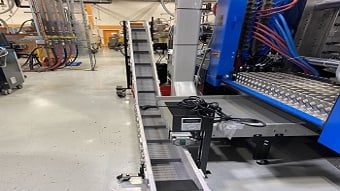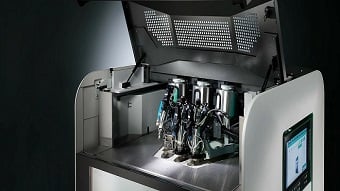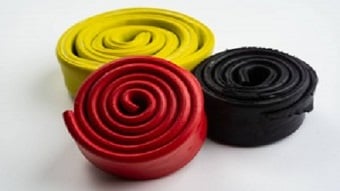Heat exchangers: Safety and operating tips
Seth Price | September 08, 2022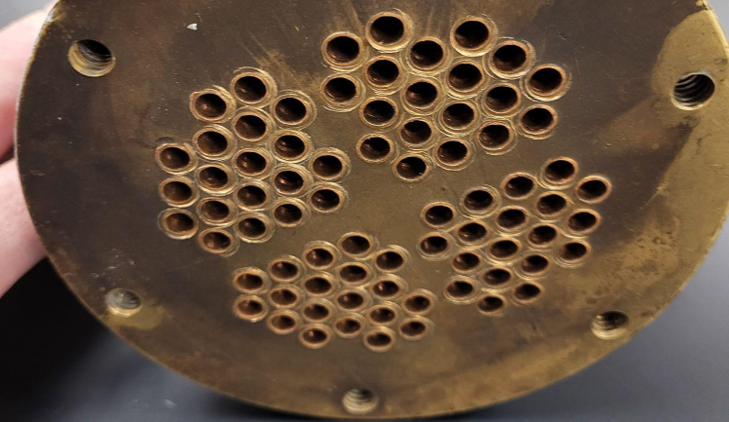
Heat exchangers heat or cool process fluids on the industrial scale. While there are several major types of heat exchangers, they typically have a few common safety hazards, all of which can be addressed through instrumentation. While this list is generic toward all heat exchangers, it can hopefully get the conversation started around heat exchanger safety and help engineers to identify hazards in their own systems. Many of these tips will also help ensure optimal heat exchanger operation.
[Browse suppliers of heat exchangers on GlobalSpec.]
Temperature excursions
Heat exchangers are often exposed to temperature extremes, both inside and outside of the system. Process fluids are often heated to high temperatures, while others, such as refrigerants, are kept extremely cold. Some heat exchangers are located outside, making them susceptible to temperature extremes based on the climate and geographic location of the plant.
The most common method of monitoring the temperature is to use thermocouples, though some heat exchangers use resistance temperature detectors (RTDs). The RTDs are typically used when tight temperature control is required, and when the temperature is not expected to change rapidly. At the very minimum, there should be four thermocouples: one to monitor the input and output streams of both process fluids. Additional sensors can be added throughout to understand how the temperature profile is changing through the process, or to search for areas of stagnant process fluid.
Phase changes
Perhaps the most important reason for keeping temperature in bounds is to prevent dangerous phase changes. While some heat exchangers are specifically designed for phase changes, many are not. For example, if the temperature climbs high enough to boil cooling water and turn it into steam, this will cause the pressure to rise rapidly. If the system is not designed for these high pressures, the results can be catastrophic.
Lower temperatures can also cause problems due to phase changes. Suppose an outdoor heat exchanger is designed for use in southern Florida. The company decides to relocate equipment to North Dakota and experiences freezing temperatures. As water freezes, it expands, which can rupture tubes in the heat exchanger. This can be particularly problematic for outdoor heat exchangers, as the temperatures may remain below freezing for months at a time, meaning the rupture may not be detected for a long time.
These phase changes can occur in mixtures, where one material boils off or freezes before another. At industrial scales, a cooling liquid that claims to be water free may have a few parts per million of water. The water may separate out and freeze, which may not sound like a big deal, but if the facility processes 300 million gallons of this substance a year, it adds up quickly.
It is worth noting that many refrigeration systems rely on boiling coolant to absorb waste heat, and these are built to withstand this phase change.
To detect phase change issues, a combination of temperature, flow and pressure monitoring must be performed. Adequate temperature monitoring will alert operators before the phase change occurs. Flow measurements can detect freezing by monitoring the flow rate before and after the heat exchanger. If the coolant is freezing in the heat exchanger, it will show up as a differential flow between the entrance and exit. Finally, pressure monitoring can detect boiling, but this should be thought of as the last layer of protection.
The problem with phase change excursions is how to deal with the chemicals in use, which will depend on the specific application. For example, water in danger of boiling can be relieved with a well-placed, appropriately-sized pressure relief valve. Flammable liquids that begin to boil should be sent to the flare instead of released into the open air.
In some cases, the chemical composition can be measured using any number of characterization techniques at sample ports before and after the heat exchanger. The composition of the material should not change as it runs through the heat exchanger; if it does, it might mean separation of a mixture.
Pressure excursions
Pressure excursions come from phase changes and from restricted flow. Phase changes have been previously discussed, but restricted flow can also raise the pressure. If a pump is pushing a process fluid into a heat exchanger, but the flow is restricted, the pressure will increase upstream of the blockage.
High pressure excursions can be detected by pressure gauges, obviously, but they can also be detected by flow meters on the inlet and outlet sides of the heat exchanger. The pressure drop across the heat exchanger under normal conditions should be documented, and if the pressure drop increases, it is possible that the flow is limited.
A high pressure excursion in a heat exchanger can be catastrophic, such as the Williams Olefins Plant. In this case, the heat exchanger ended up becoming isolated from its overpressure relief valve due to a design change that had not been properly vetted.
Low pressure can also be a problem if a pump is being used to pull the process fluid through the heat exchanger. Besides using a pressure gauge, the pump can be monitored for vibration or current draw. If the flow becomes restricted, the pump may draw more current. This can be detected by measuring current directly, measuring voltage drop across a shunt resistor, or indirectly with a proper selection of fuses or breakers. Also, the low flow can lead to cavitation on the input side of the pump. This can be monitored audibly or by using accelerometers to measure vibration signals.
Corrosion and fouling
How might a heat exchanger flow be restricted or blocked? The process fluids can corrode the surfaces they touch, leading to rust build up or scaling that can reduce the diameter of the tubes and restrict flow. Also, impurities in the process fluid can build up in low-velocity areas of the heat exchanger. For example, water that is being pumped from a nearby lake may have a small amount of sand and leaves, or a small amount of resin that is more dense and less viscous could collect in these areas as well.
The most effective prevention methods are to add filtering and purification of the process fluids. This will not capture all of the impurities, but it will reduce them, provided changing filters is added to the maintenance schedule.
When water is used, the measurement of the total dissolved solids (TDS) and pH can give an indication of the propensity for corrosion. If a record of TDS is kept over time, changes in water chemistry can be detected, which can indicate corrosion.
To mitigate corrosion, sometimes sacrificial anodes are placed in strategic locations. Often, these are a bolt with a plug of magnesium, zinc or another more electronegative metal. This can be easily forgotten, as it appears as a bolt head on the outside of the heat exchanger, but it must be checked and periodically replaced.
Leaks
Leaks can occur due to corrosion, mechanical damage, overpressure and other such conditions.
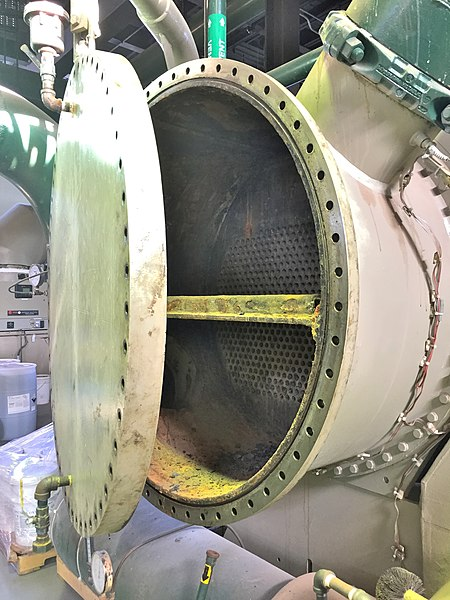 A leak between the tubes and the shell would be difficult to detect. Source: Saud/CC BY-SA 4.0Leaks between the shell and the outside can often be spotted visibly, using periodic inspection or chemical “sniffers” for some chemicals. Acoustic sensors can be used to detect leaking vapor phase, such as steam, as the escaping vapor sounds different from the heat exchanger under normal operations. Shell leaks with a large temperature difference can be detected with thermal cameras as well.
A leak between the tubes and the shell would be difficult to detect. Source: Saud/CC BY-SA 4.0Leaks between the shell and the outside can often be spotted visibly, using periodic inspection or chemical “sniffers” for some chemicals. Acoustic sensors can be used to detect leaking vapor phase, such as steam, as the escaping vapor sounds different from the heat exchanger under normal operations. Shell leaks with a large temperature difference can be detected with thermal cameras as well.
Leaks between the inner surfaces can be much harder to detect, but very important to find. The two process fluids should not mix, and so a leak between the tube side and shell side in a shell and tube heat exchanger is not permissible. In the worst circumstances, these two fluids may react. At the very least, both process fluid streams will be contaminated. Worse than that, the leak may be difficult to detect.
To find a leak between shell and tube, flow meters can be placed on each stream. If the inlet side and the outlet side do not match, it could indicate a phase change, or it could indicate a leak between the shell and tube.
Summary
[Learn more about heat exchangers on GlobalSpec.]
This list of issues is not exhaustive. The safest practice for evaluating heat exchanger surety is to start by performing a full Process Hazard Analysis (PHA) on the heat exchanger system, where all potential hazards are identified. This PHA should include engineers and both maintenance and operations technicians who are responsible for the system. Once all the hazards have been identified, appropriate instrumentation, Standard Operating Procedures (SOPs), Preventive Maintenance (PM) schedules and other safety and quality systems can be implemented.
